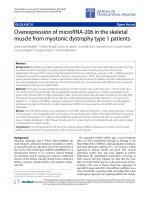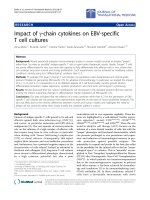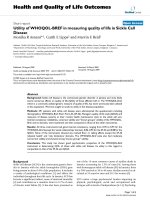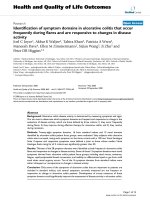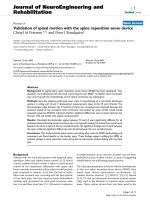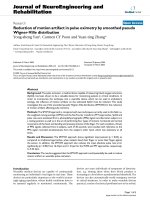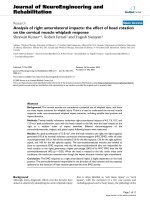báo cáo hóa học:" Characteristics of non-AIDS-defining malignancies in the HAART era: a clinico-epidemiological study" doc
Bạn đang xem bản rút gọn của tài liệu. Xem và tải ngay bản đầy đủ của tài liệu tại đây (259.07 KB, 7 trang )
RESEARCH Open Access
Characteristics of non-AIDS-defining malignancies
in the HAART era: a clinico-epidemiological study
Nicolas Dauby, Stéphane De Wit
*
, Marc Delforge, Valentina Coca Necsoi and Nathan Clumeck
Abstract
Background: Non-AIDS-defining malignancies (NADM) are becoming a major cause of mortality in the era of
highly active antiretroviral therapy. We wished to investigate the incidence, risks factors and outcome of NADM in
an urb an cohort.
Methods: We carried out an observational cohort of HIV patients with 12,746 patient-years of follow up between
January 2002 and March 2009. Socio-demographics and clinical characteristics of patients diagnosed with NADM
were retrospectively compared with the rest of the cohort. Causes of death and risk factors associated with NADM
were assessed using logistic regression. Survival analyses were performed with Kaplan-Meier estimates. Cancer
incidences were compared with those of the general population of the Brussels-Capital Region using the
standardized incidence ratio (SIR).
Results: Forty-five NADM were diagnosed. At inclusion in the study, patients with NADM were older than patients
without NADM (47 years vs. 38 years, p < 0.001), had a longer history of HIV infection (59 months vs. 39 months, p
= 0.0174), a lower nadir CD4 count (110 cells/mm
3
vs. 224 cells/mm
3
, p < 0.0001) and a higher rate of previous
AIDS events (33% vs. 20%, p = 0.0455) and of hepatitis C virus co-infection (22.2% vs. 10%, p = 0.0149). In
multivariate analysis, age over 45 at baseline (OR 3.25; 95% CI 1.70-6.22) and a nadir CD4 count of less than 200
cells/mm
3
(OR 3.10; 95% CI 1.40-6.87) were associated with NADM. NADM were independently associated with
higher mortality in the cohort (OR 14.79; 95% CI 6.95-31.49). Women with cancer, the majority of whom were of
sub-Saharan African origin, had poo rer survival compared with men. The SIR for both sexes were higher than
expected for Hodgkin’s lymphoma (17.78; 95% CI 6.49-38.71), liver cancers (8.73; 95% CI 2.35-22.34), anal cancers
(22.67; 95% CI 8.28-49.34) and bladder cancers (3.79; 95% CI 1.02-9.70). The SIR for breast cancer was lower in
women (SIR 0.29; 95% CI 0.06-0.85).
Conclusions: Age over 45 and a nadir CD4 count of less than 200 cells/mm
3
were predictive of NADM in our
cohort. Mortality was high, especially in sub-Saharan African women. Cancers with increased incidences were
Hodgkin’s lymphoma and anal, bladder and liver cancers in both sexes; women had a lower incidence of breast
cancer.
Background
HIV infection is associated with an increased incidence
of certain types of cancer, i.e., Kaposi sarcoma, non-
Hodgkin’s lymphoma and cervical cancer, all linked with
profound immunosuppression [1]. T hese cancers have
been classified as AIDS-defining malignancies (ADM) by
the Centers for Diseas e Control and Prevention since
1993.
The introduction of highly active antiretroviral therapy
(HAART) led to a change in the causes of hospitaliza-
tion and death of HIV-infected patients, with a signifi-
cant decrease in AIDS-related causes, like ADM, but
with a rise in cardiovascular diseases and non-AIDS-
defining malignancies (NADM); these became major
causes of mortality in the HAART era [2-4].
Various registry-linked epidemiological studies have
stressed an increased risk of malignancies in HIV
patients in the era of HAART in comparison with the
general population [5-7]. Causative factors were first
thought to be a higher proportion of risk factors in the
* Correspondence:
Division of Infectious Diseases, CHU St-Pierre, Université Libre de Bruxelles,
Brussels, Belgium
Dauby et al. Journal of the International AIDS Society 2011, 14:16
/>© 2011 Dauby et al; licen see BioMed Central Ltd. This is an Open Access article distributed under the terms of the Creative Commons
Attribution Lice nse ( .0), which permits unrestricted use, distribution, and reproduction in
any medium, provided the original work is properly cited.
HIV populations, such as tobacco smoking or intrave-
nous drug use. However, more data are now pointing to
the role of prolonged immunosuppression, indepen-
dently of other risk factors.
A meta-analysis comparing the incidence of cancer in
transplant patients and HIV-infected patients demon-
strated that in terms of cancer risk factors, these two
distinct populations have increased incidences of various
neoplasms, such as Hodgkin’s lymphoma, anal cancer,
lung cancer and liver cancer [8]. Recent data have con-
firmed the impact of long-term immunosuppression, as
assessed by nadir and current CD4 cell count on t he
occurrence of NADM [9].
We report our experience with NADM in a single-
centre cohort of HIV-infected patients during the late
HAARTera.Wesoughttoidentifyrisksfactorsasso-
ciated with the occurrence of NADM, to describe the
characteristics of patients diagnosed with a NADM and
to compare the incidence of these cancers in our cohort
with th e population of the Brussels-Capital Region. We
also provide a descriptive analysis of cancers diagnosed
during the study period, along with the treatments
received, as well as their complications.
Methods
Study population
The Brussels St-Pierre HIV cohort is an urban cohort
initiated in 1983 at the University Hospital S t-Pierre,
located in downtown Brussels, Belgium. Since 1983, it has
accumulated data on more than 5000 patients. Socio-
demographics characteristics (birth date, ethnicity), data
about HIV infection (date of diagnosis, serial CD4 counts
and viral loads, AIDS diagnosis), treatment (drugs, date of
initiation or change, reason for change), co-infections with
hepatitis B and C viruses, and o ccurrence of adverse events
(cancer, opportunistic infection, hospitalization, death) are
prospectively collec ted a nd encoded in a database.
Patients are recruited through doctor referral from the
outpatient and inpatient HIV units. In 2009, there were
2302 patients under active follow up, made up of 59%
males, 49% Caucasians and 47% sub-Saharan Africans.
Transmission origin was mainly heterosexual (57%) and
homo/bisexual (32%), while intravenous drug use
accounted for only 4%.
For the present study, patients w ho were diagnosed
with a NADM bet ween 1 January 2 002 and 31 Marc h
2009 were retrospectively compared with the rest of the
cohort (e. g., those who did not have a diagnosis o f
NADM). Data about demographics, mode of transmis-
sion and HIV characteristics were retrieved from the
database and comparisons were made b etween the two
groups. Data were retrieved from the database for
patients who met the following criteria: age over 18, and
at least two contacts in the outpatient clinic or one
hospitalization and at least one contact in the outpatient
clinic during the study period.
A retrospective review of the clinical charts of the
patient with NADM was performed and the following
data were retrieved: symptoms; method of diagnosis;
treatment received (surgery, chemotherapy, radiother-
apy, other); complications obse rved for each treatment;
and occurrence of any opportunistic infection in che-
motherapy recipients within 12 months of initiation of
the treatment. The study was approved by the local ethi-
cal review committee of the St-Pierre Hospital.
Statistical analysis
Categorical data were compared with Fisher or Chi-
square tests. Continuous variables were compared with
the non-parametric Mann-Whitney test. Risks factors
associated with death and NADM diagnosis were
assessed using logistic regression with calculation of
odds ratio (OR). For NADM patients, Kaplan-Meier
analyses were made since the time of cancer diagnosis.
Statistical analysis were performed with MedCalc for
Windows, version 9.5.0.0 for the Kaplan-Meier analysi s
(MedCalc Software, Mariakerke, Belgium), GraphPad
Prism version 5.01 for Windows for analysis of the con-
tinuous and categorical data (GraphPad Software, San
Diego, California, USA), and Stata 11 (StatCorp LP, Col-
lege Station, Texas, USA) for the logistic regression.
Calculations of the standardized incidence ratio
The expected numbers of cancers were calculated by
multiplying the person-years at risk by the appropriate
age- and gender-specific incidence r ates, which were
obtained from the Belgian Cancer Registry (http://www.
registreducancer.be/) for the year 2005 (middle of the
study period). We used data from the Brussels-Capital
Region where our centre is located. The region is the
largest urban centre of Belgium, with a population of
about 1.1 million, and has the highest proportion of for-
eigners in Belgium (almost 30%) [10]. People from the
Democratic Republic of Congo, which represent the
main populat ion of sub-Saharan African origin in
Belgium, live mainly in the Brussels-Capital Region [11].
Sub-Saharan Africans account for about 12% o f the leg-
ally registered foreign population of the region [10].
The standardized incidence ratio (SIR) was calculated
using the ratio of obser ved to expected numbers of can-
cer cases, and 95% confidence intervals (CIs) were calcu-
lated. Non-melanoma skin cancers were excluded
because they were at risk of being under-reported and
are not associated with high morbidity or mortality.
Results
A t otal of 3126 patients who met the inclusion criteria
were included, w ith 12,746 patient-years of follow up.
Dauby et al. Journal of the International AIDS Society 2011, 14:16
/>Page 2 of 7
Forty-five NADM were diagnosed during the study
period (Table 1). Two cases o f NADM were e xcluded
from the analysis: one breast cancer because the diagno-
sis of HIV was made after the diagnosis of cancer; and
one thyroid cancer because the diagnosis of cancer
was made abroad and available data were insufficient.
Of note, three patients diagnosed with NADM were
previously diagnosed with an ADM: one with non-
Hodgkin’s lymphoma; and two with Kaposi sarcoma.
Patients characteristics
Characteristics of the NADM patients compared with
the rest of the cohort are summarized in Table 2.
Patients diagnosed with NADM were older and had a
longer history of HIV infection. There were no differ-
ences in the proportions of m ales, Africans, men who
have sex with men (MSM) and smokers. A two-fold
higher rate of hepatitis C virus co-infection was noted
in the NADM group. When considering CD4 cell count
at inclusion in the study, no difference was noted, but
nadir CD4 count was lower for NADM patients. Both
groups had a similar pro portion of subjects on HAART
at inclusion, and the cumulative exposure to HAART
was not statistically different between the two groups.
An 18-fold increase of mortality was observed for the
NADM group. In a multivariate analysis (Table 2) us ing
logistic regression, the two factors independently asso-
ciated with the risk of NADM during the study period
wereageover45atbaselineandanadirCD4countof
less than 200 cells/mm
3
.
When looking at the NADM group, at the time of
cancer diagnosis, median CD4 count was 352 cells/mm
3
and 51.1% (n = 23) of the patients had undetectable
viral loa ds (< 50 copies/ml). In patients with detectable
viral loads, values ran ged from 1330 to 482,000 copies/
ml (median 87,100 copies/ml). Be fore cancer diagnosis,
53.3% of the patients had undetectable viral loads for at
least s ix months. In the cancer group, differences were
found between the two ethnic groups represented. Afri-
cans were mostly women, w hereas Caucasians were
mostly males (male:female ratio of 0.7 and 7.3, respec-
tively; data not shown). Caucasian patients were more
likely than African patients to be smokers (65.4 vs 25%,
p < 0.01). Sex between men as a mode of transmission
was frequent in t he Caucasian population, but absent in
the African population (42.3% vs 0%).
Cancer, treatment characteristics and treatment
complications
The majority of patients (65%) were symptomatic at
diagnosis, while 13% were diagnosed after a screening
procedure and 15% after an imaging diagnostic proce-
dure for unrelated disease in asympto matic patients. Of
note, all prostate cancers were diagnosed after prostate-
specific antigen testing (data not shown). The other
cancers diagnosed after screening were hepatocellular
carcinoma (alpha-foeto protein testing, n = 1) and breast
cancer (mammography, n = 1). Histopatholog y was
available in 42 cases (91%), and non-surg ical biopsy was
the most used tool (n = 31; 67%).
Treatments received were as follows: chemotherapy
(54.3%, n = 25), surgery (41.3%, n = 19), radiotherapy
(43.5%, n = 20) and hormonotherap y (8.7%, n = 4). Non-
AIDS-related infections were the most com mon comp li-
cations in chemotherapy recipients (32%, n = 8), with
febrile neutropenia (n = 5) the most frequent. Opportu-
nistic infections within 12 months of initiation of che-
motherapy were observed in five patients (20%): lung
tuberculosis (n = 1), lung Mycobacterium xe nopi infec-
tion (n = 1), lung aspergillosi s (n = 1), shingles (n = 1)
and oesophageal candidia sis along with shingles (n = 1).
Haematological complications (neutropenia, severe ane-
mia, pancytopenia) were the second most common com-
plications and occurred in 28% of the patients (n = 7).
Renal failure was the most common metabolic compli-
cation (n = 3), followed by toxic cardiopathy (n = 1) and
chemotherapy-related pneumonitis (n = 1). Post-opera-
tive complications occurred in 31.6% (n = 6) of patients
who underwent surgical procedures: small-bowel occlu-
sion, bladder perforation, bacterial pneumonia, Entero-
bacter cloacae peritonitis along with two deaths (one
following resection of a brain metastasis of breast cancer
and the other after hepatectomia in a patient with liver
cancer). Radiotherapy complications occur red in 25% of
the cases (n = 5) and were localized dermatitis in all
cases, except for one case of herpetic infection.
Causes of mortality in the cohort and survival after
cancer diagnosis
We used logistic regression to assess the causes of mor-
tality during the study period (Table 3). Multivariate
Table 1 Non-AIDS-defining malignancies distribution
during the study period
Cancer type n %
Hodgkin’s lymphoma 6 13.3
Anal 6 13.3
Lung 5 11.1
Hepatocellular carcinoma 4 8.9
Prostate 4 8.9
Bladder 4 8.9
Breast 3 6.7
Head & neck 3 6.7
Others 10 22.2
All 45 100
Others: vagina, stomach, testicular, oesophagus, acute leukemia, colon, kidney,
skin melanoma, vulva and ovary cancer.
Dauby et al. Journal of the International AIDS Society 2011, 14:16
/>Page 3 of 7
analysis revealed that NADM was independently asso-
ciated with mortality, with an odds ratio ( OR) of 14.79.
Aft er diagnosis of cancer, mean survival was 27 months
(data not shown). Females had a lower survival in com-
parison with males (14 vs. 32 months, p = 0.037; HR =
3.004; 95% CI 1.069-8.442) (Figure 1).
Standardized incidence ratio
Higher than expected incidence rates were found for
three cancers in males: Hodgkin’s lymphoma (SIR 12.81;
95% CI 3.45-32.81), liver cancer (SIR 8.64; 95% CI 1.74-
25.23) and anal cancer (SIR 41.14; 95% CI 13.26-96.00).
For women, higher incidence rates were found for
Table 2 Characteristics of the patients diagnosed with a non-AIDS-defining malignancy compared with the cohort
Cohort NADM No NADM Univariate Multivariate
n % n % n % p value OR CI 95% p value OR CI 95%
Patients 3126 100 45 1.4 3081 98.6
Included after 1 January 2002 1300 41.6 10 22.2 1290 41.9
Median follow up 49 60 49
Age > 45 at baseline 703 22.49 24 53.33 679 22.04 < 0.0001 4.04 2.24-7.31 < 0.0001 3.25 1.70-6.22
Smoking 984 31.5 19 42.2 965 31.3 0.1611
MSM 875 28.0 11 24.4 864 28.0 0.714
Male 1791 57.3 30 66.7 1761 57.2 0.2004
African origin 1582 50.6 19 42.2 1563 50.7 0.3255
HCV 319 10.2 10 22.2 309 10.0 0.0149 2.56 1.3 - 5.2 0.057 2.10 0.98-4.53
HBV 192 6.1 4 8.5 188 6.1 0.6453
HIV diagnosis >5 years 1154 36.9 21 46.67 1133 36.77 0.1722
Nadir CD4 count (cells/mm
3
) 220 110 224
Nadir CD4 count < 200/mm
3
before 1 January 2002
1410 45.10 35 77.78 1375 44.63 < 0.0001 4.34 2.14-8.80 0.005 3.10 1.40-6.87
CD4 count at
baseline (cells/mm
3
)
402 375.5 405 0.2782
VL at baseline 559 326 573 0.6767
HAART use at baseline 78.0 71.4 78.1 0.7514
Cumulative duration of HAART 39 50 38 0.1201
Time since initiation of HAART 45 55 44 0.0279
AIDS events before inclusion 635 20.31 15 33.3 620 20.12 0.0455 1.98 1.1 - 3.7 0.28 1.47 0.73-2.96
Death during study period 146 4.67 20 44.4 126 4.1 < 0.0001 18.76 10.1 - 34.7
Multivariate analysis was performed using logistic regression. Durations are in months. VL: viral load. OR: odds ratio.
Table 3 Analysis of the causes of death during the study period using logistic regression
Univariate Multivariate
Factor OR 95% CI p value OR 95% CI p value
Nadir CD4 count <200 cells/mm
3
6.46 4.18 10.00 < 0.001 4.41 2.57 7.56 < 0.001
HCV positive 3.17 2.12 4.74 < 0.001 2.37 1.51 3.71 < 0.001
HbS Ag positive 1.70 0.98 2.97 0.061
NADM diagnosis 18.46 9.99 34.1 < 0.001 14.79 6.95 31.49 < 0.001
Previous AIDS diagnosis 5.29 3.78 7.41 < 0.001 3.21 2.16 4.77 < 0.001
Age over 45 2.63 1.87 3.68 < 0.001 2.10 1.41 3.11 < 0.001
MSM 0.51 0.33 0.79 0.002 0.66 0.40 1.09 0.108
Time since HIV diagnosis >5 years 2.71 1.93 3.8 < 0.001 1.63 1.09 2.42 0.016
MSM: men who have sex with men. NADM: non-AIDS-defining malignancy. OR: odds ratio.
Dauby et al. Journal of the International AIDS Society 2011, 14:16
/>Page 4 of 7
Hodgkin’ s lymphoma (SIR 65.37; 95% CI 13.14-191.00)
and bladder cancer (SIR 12.11; 95% CI 1.36-43.72),
while a lower incidence rate for breast cancer was
observed (SIR 0.29; 95% CI 0.06-0.85). When consider-
ing both sexes, higher incidence rates were observed for
Hodgkin’ s lymphoma (SIR 17.78; 95% CI 6.49-38.71),
liver (SIR 8.73; 95% CI 2.35-22.34), bladder (SIR 3.79;
95% CI 1.02-9.70) and anal cancers (SIR 22.67; 95% CI
8.28-49.34). No difference in incidence was found in
males for lung, prostate, head and neck, bladder and all
cancers (excluding non-melanoma skin cancer), while in
females no difference was found for lung, liver, anal and
all cancers (excluding non-melanoma skin cancer).
Discussion
NADM are becoming a significant concern in the man-
agement of chronically HIV-infected patients on
HAART. Aging per se might be an explanation for the
increased incidence of NADM, but epidemiological stu-
dies have shown that compared with the general popula-
tion and after standardization for age, HIV-infected
patients are at i ncreased risk of certain types of cancer
[6,12-14]. This is the case for c ancer linked to chronic
viral infections, such as anal cancer (Human papilloma
virus), Hodgkin’s lymphoma (Epstein-Barr virus) and
liver cancer (HCV and HBV) [8], and also for epithelial
cancers, such as lung cancer independently of a smoking
history [15].
Despite a low number of cancer cases, we have been
able to detect in our cohort a significantly higher inci-
dence for three types of cancer in comparison with the
general p opulation of the Brussels-Capital Region after
standardization for age: Hodgkin’s lymphoma, anal can-
cer and liver cancer. The li nk between immunosuppres-
sion and these cancers is we ll known: the y are indeed
found in excess in both transplant patients and HIV
patients [8].
We did not find an excess rate for lung cancer, one of
the most frequent NADM in HIV patients [6]. An
explanation might be the high incidence of lung cancer
in the Belgian population in comparison with other
European countries, especially in males [16], or the low
proportion of intravenous drug use in our cohort, a
known risk factor for lung cancer in HIV patients [17].
An intriguing finding is the lower incidence of breast
cancer in HIV women. A la rge study involving 85,268
HIV-infected women in the USA has previously
reported a lower SIR for breast cancer, independently of
the CD4 count [18]. Similar results have been reported
in studies in Europe and sub-Saharan African, both
before and during the HAART era [19-21]. Data from
the US have shown that HIV-infected women have
more probability of undergoing a screening mammogra-
phy, ruling out an underestimation of this cancer [22 ].
In our cohort, such an explanation could not be dis-
carded as only one breast cancer out of three was diag-
nosed after a screening mammography. Interestingly, a
recently published study has shown that women infected
with CXCR4-tropic virus had lower breast cancer inci-
dence compared with women with CCCR5- tropic virus
[23]. The chemokine receptor CXCR4 is highly
expressed by b reast cancer cells and is involved in
metastasis formation [24]. These e pidemiological data
corroborate in vitro experiments that have demonstrated
that CXCR4-tropic virus interact with breast cancer
cells and induce their apoptosis [25]. Unfortunately, data
about virus tropism are not available for our patients.
We also noted an increased incidence of bladder can-
cer in women and in the combined sample o f both
women and men. The incidence of bladder cance r is
increased in transplant patients but not in HIV patients
[8]. Data regarding this cancer in HIV patients are
scarce: a recent review of the publishe d cases suggest a
younger age at diagnosis and a predominance of males
[26].
Interpretation of the SIR results is limited by the small
numbers of cases and t he use of the cancer incidence
data from the Brussels-Capital Region, while patients of
African origin are over-represented in our cohort in
comparison with the general population.
Multivariate analysis allowed us to identify two predic-
tors of NADM in our cohort, namely age over 45 and a
nad ir CD4 count of less than 200 cells/m m
3
.Agingisa
known risk factor for cancer and has already been
shown to be independently associated with NADM in
other studies [27,28]. Immunodeficiency assessed by
Figure 1 Survival after cancer diagnosis. Survival after cancer
diagnosis is lower for women compared to men (14 vs 32 months;
p = 0,037, Logrank test).
Dauby et al. Journal of the International AIDS Society 2011, 14:16
/>Page 5 of 7
both nadir and current CD4 cell count [9,12, 29,30] has
been shown to predict the occurrence of NADM in var-
ious studies. A recent prospective French study invol-
ving 52,278 patients followed up between 1998 and
2006 has shown that at a CD4 count below 500 cells/
mm
3
,thecancerrisk(Hodgkin’s lymphoma, liver and
lung cancer) progressively increased: the highest risk
was when CD4 count was below 50 cells/mm
3
[9]. The
concept of “immunological surveillance” could be an
explanation: the decrease of CD4+ T cells and other
immune dysfunctions induced by HIV infection lead to
a decrease of both the control of oncogenic viruses like
EBV [31] and the destruction of malignant precursors
[32]. Direct oncogenic effects of the virus itself could
also be implied. Indeed, in vitro experiments suggest
that the tat HIV protein could interfere with DNA
repair mechanisms and apoptosis increasing the risk of
malignant transformation in the host cells [33,34]. How-
ever, clinical studies are discordant about the risk of
NADM and their relation to HIV viral load. I n one
study, uncontrol led viral replication ( RNA >4 log10
copies/ml) was associated with the occurrence of non-
AIDS severe clinical events, including NADM (9.5% of
non-AIDS clinical events) [35]. In another study, an
uncontrolled HIV-RNA level was associated with the
occurrence of an ADM but not of a NADM [30]. We
were unable to find such association in our study in
multivariate analysis.
NADM are now a leading cause of death in HIV
patients on HAART. In 2005 in France, 34% of deaths
in HIV-positive patients were cancer related, 61% being
non-AIDS related [36]. In our study, the diagn osis of
NADM during the study raised the mortality by up to
15-fold. Survival after cancerdiagnosiswaspoorand
women had a significantly lower survival rate than men.
Women with NADM were mostly of African origin.
Various arguments suggest a heightened vulnerability of
this particular group. First, this group is known to
experienc e socio-economic precariousness: 41% of HIV-
infected women of sub-Saharan Africa origin who died
in 2005 in France were living in socio-economic precar-
iousness co mpared with 23% of women born in France
[37]. In our centre, 86% of African women were living
on less than 1000 euros per month [38]. In the latter
study, the majority of them were widowed and had chil-
dren, 15% of whom were also HIV infected. Psychologi -
cal distress was also frequent, along with poor treatment
adherence.
A more advanced disease at diagnosi s, a lower perfor-
mance status and a higher tumour grade account for
the lower survival observed in HIV-positive patients in
comparison with HIV-negative patients [1]. HIV-
infected patients may also be at increased risk of com-
plications during chemotherapy: the combination of
HIV-induced immunodeficiency with the haematological
and metabolic toxicities of anti-cancer agents, poten-
tially enhanced by HAART [1,39], makes HIV patients
at higher risk of infectious complications and poorer
survival. Infectious complications in pat ients who
received chemotherapy were found in our study in up to
30% of patients, and opportunistic infections were
observed in 20% of patients who received chemotherapy
within the 12 months following the first date of
chemotherapy.
Conclusions
In our study, NADM with increased incidences were
anal cancer, bladder cancer, Hodgkin’s lymphoma and
liver cancer. Immunosuppression, as assesse d by a nadir
CD4 cell count of less than 200 cells/mm
3
, was indepen-
dently associated with the occurrence of NADM, along
with an age of over 45 years. Mortality was high, espe-
cially in women, and infectious complicat ions were the
most frequent. Women from sub-Saharan Africa seem
to be particularly vulnerable, and a multidisciplinary
approach is required in the management of these
patients. Efforts to reduce cancer incidences should be
focused on improving CD4 counts with adequate ther-
apy, prevention of immunosuppression with earlier
treatment initiation, lowering of cancer risk factors, and
appropriate screening programmes for cancers where
this strategy has been shown to be effective [40].
Acknowledgements
We would like to thank Dr Françoise Renard and Julie Francart (Registre
Belge du Cancer, Brussels) for providing the detailed cancer incidences data
and Dr André Sasse (Institute of Public Health, Brussels) for help with the SIR
calculations.
Authors’ contributions
ND participated in the study design, reviewed the clinical charts, performed
data analysis and statistical analysis, and writing of the paper. SDW
participated in the study design, data analysis, and writing of the paper. MD
extracted the data, and performed part of the statistical analysis. VCN
encoded the data, and was in charge of the cohort. NC participated in study
design, and reviewed the draft. All authors have read and approved the final
manuscript.
Competing interests
The authors declare that they have no competing interests.
Received: 21 September 2010 Accepted: 28 March 2011
Published: 28 March 2011
References
1. Spano JP, Costagliola D, Katlama C, Mounier N, Oksenhendler E, Khayat D:
AIDS-related malignancies: state of the art and therapeutic challenges.
J Clin Oncol 2008, 26:4834-4842.
2. Lewden C, Salmon D, Morlat P, Bevilacqua S, Jougla E, Bonnet F, Heripret L,
Costagliola D, May T, Chene G: Causes of death among human
immunodeficiency virus (HIV)-infected adults in the era of potent
antiretroviral therapy: emerging role of hepatitis and cancers, persistent
role of AIDS. Int J Epidemiol 2005, 34:121-130.
3. Sackoff JE, Hanna DB, Pfeiffer MR, Torian LV: Causes of death among
persons with AIDS in the era of highly active antiretroviral therapy: New
York City. Ann Intern Med 2006, 145:397-406.
Dauby et al. Journal of the International AIDS Society 2011, 14:16
/>Page 6 of 7
4. Clifford GM, Franceschi S: Cancer risk in HIV-infected persons: influence of
CD4(+) count. Future Oncol 2009, 5:669-678.
5. Hessol NA, Pipkin S, Schwarcz S, Cress RD, Bacchetti P, Scheer S: The
impact of highly active antiretroviral therapy on non-AIDS-defining
cancers among adults with AIDS. American Journal of Epidemiology 2007,
165:1143-1153.
6. Dal Maso L, Polesel J, Serraino D, Lise M, Piselli P, Falcini F, Russo A,
Intrieri T, Vercelli M, Zambon P, Tagliabue G, Zanetti R, Federico M,
Limina RM, Mangone L, De Lisi V, Stracci F, Ferretti S, Piffer S, Budroni M,
Donato A, Giacomin A, Bellu F, Fusco M, Madeddu A, Vitarelli S,
Tessandori R, Tumino R, Suligoi B, Franceschi S: Pattern of cancer risk in
persons with AIDS in Italy in the HAART era. Br J Cancer 2009,
100:840-847.
7. Engels EA, Pfeiffer RM, Goedert JJ, Virgo P, McNeel TS, Scoppa SM,
Biggar RJ: Trends in cancer risk among people with AIDS in the United
States 1980-2002. AIDS 2006, 20:1645-1654.
8. Grulich AE, van Leeuwen MT, Falster MO, Vajdic CM: Incidence of cancers
in people with HIV/AIDS compared with immunosuppressed transplant
recipients: a meta-analysis. Lancet 2007, 370:59-67.
9. Guiguet M, Boue F, Cadranel J, Lang JM, Rosenthal E, Costagliola D: Effect
of immunodeficiency, HIV viral load, and antiretroviral therapy on the
risk of individual malignancies (FHDH-ANRS CO4): a prospective cohort
study. Lancet Oncol 2009, 10(12):1152-1159.
10. Ministère de la Région de Bruxelles-Capitale - Institut Bruxellois de
Statistiques et d’Analyse IBSA - Cellule Statistiques: Structure de la
Population. Indicateurs Statistiques de la Région de Bruxelles-Capitale IRIS
Editions; 2009.
11. Schoonvaere Q: Belgique - RD Congo: 50 années de migration. Etude de la
migration congolaise et de son impact sur la présence congolaise en Belgique:
analyse des principales données démographiques Bruxelles/Louvain-la-neuve:
UCL/CECLR; 2010.
12. Powles T, Robinson D, Stebbing J, Shamash J, Nelson M, Gazzard B,
Mandelia S, Moller H, Bower M: Highly active antiretroviral therapy and
the incidence of non-AIDS-defining cancers in people with HIV infection.
J Clin Oncol 2009, 27:884-890.
13. Long JL, Engels EA, Moore RD, Gebo KA: Incidence and outcomes of
malignancy in the HAART era in an urban cohort of HIV-infected
individuals. AIDS 2008, 22:489-496.
14. Engels EA, Biggar RJ, Hall HI, Cross H, Crutchfield A, Finch JL, Grigg R,
Hylton T, Pawlish KS, McNeel TS, Goedert JJ: Cancer risk in people infected
with human immunodeficiency virus in the United States. Int J Cancer
2008, 123 :187-194.
15. Bazoes A, Bower M, Powles T: Smoke and mirrors: HIV-related lung
cancer. Curr Opin Oncol 2008, 20:529-533.
16. Belgian Cancer Registry: Cancer incidences in Belgium 2004-2005 Brussels;
2008.
17. Cadranel J, Garfield D, Lavole A, Wislez M, Milleron B, Mayaud C: Lung
cancer in HIV infected patients: facts, questions and challenges. Thorax
2006, 61:1000-1008.
18. Goedert JJ, Schairer C, McNeel TS, Hessol NA, Rabkin CS, Engels EA:
Risk of
breast, ovary, and uterine corpus cancers among 85,268 women with
AIDS. Br J Cancer 2006, 95:642-648.
19. Amir H, Kaaya E, Kwesigabo G, Kiitinya J: Breast cancer before and during
the AIDS epidemic in women and men: a study of Tanzanian Cancer
Registry Data 1968 to 1996. Journal of the National Medical Association
2000, 92:301.
20. Herida M, Mary-Krause M, Kaphan R, Cadranel J, Poizot-Martin I, Rabaud C,
Plaisance N, Tissot-Dupont H, Boue F, Lang JM, Costagliola D: Incidence of
non-AIDS-defining cancers before and during the highly active
antiretroviral therapy era in a cohort of human immunodeficiency virus-
infected patients. J Clin Oncol 2003, 21:3447-3453.
21. Intra M, Gentilini O, Brenelli F, Chagas E, Veronesi U, Sandri M: Breast
cancer among HIV-infected patients: The experience of the European
Institute of Oncology. Journal of Surgical Oncology 2005, 91:141-142.
22. Preston-Martin S, Kirstein LM, Pogoda JM, Rimer B, Melnick S, Masri-Lavine L,
Silver S, Hessol N, French AL, Feldman J, Sacks HS, Deely M, Levine AM: Use
of mammographic screening by HIV-infected women in the Women’s
Interagency HIV Study (WIHS). Prev Med 2002, 34:386-392.
23. Hessol NA, Napolitano LA, Smith D, Lie Y, Levine A, Young M, Cohen M,
Minkoff H, Anastos K, D’Souza G, Greenblatt RM, Goedert JJ: HIV Tropism
and Decreased Risk of Breast Cancer. PLoS ONE 2010, 5:e14349.
24. Luker K, Luker G: Functions of CXCL12 and CXCR4 in breast cancer.
Cancer Letters 2006, 238:30-41.
25. Misumi S, Endo M, Inatsu A, Hashimoto K, Takamune N, Shoji S: Human
Immunodeficiency Virus-Induced Apoptosis of Human Breast Cancer
Cells Via CXCR4 is Mediated by the Viral Envelope Protein But Does Not
Require CD4. Current HIV Research 2008, 6:34-42.
26. Gaughan EM, Dezube BJ, Bower M, Aboulafia DM, Bohac G, Cooley TP,
Pantanowitz L: HIV-associated bladder cancer: a case series evaluating
difficulties in diagnosis and management. BMC Urol 2009, 9:10.
27. Monforte A, Abrams D, Pradier C, Weber R, Reiss P, Bonnet F, Kirk O, Law M,
De Wit S, Friis-Moller N, Phillips AN, Sabin CA, Lundgren JD: HIV-induced
immunodeficiency and mortality from AIDS-defining and non-AIDS-
defining malignancies. AIDS 2008, 22:2143-2153.
28. Crum-Cianflone N, Hullsiek KH, Marconi V, Weintrob A, Ganesan A,
Barthel RV, Fraser S, Agan BK, Wegner S: Trends in the incidence of
cancers among HIV-infected persons and the impact of antiretroviral
therapy: a 20-year cohort study. AIDS 2009, 23:41-50.
29. Reekie J, Kosa C, Engsig F, Monforte AdA, Wiercinska-Drapalo A,
Domingo P, Antunes F, Clumeck N, Kirk O, Lundgren JD, Mocroft A:
Relationship between current level of immunodeficiency and non-
acquired immunodeficiency syndrome-defining malignancies. Cancer
2010, 116 :5306-5315.
30. Bruyand M, Thiebaut R, Lawson-Ayayi S, Joly P, Sasco AJ, Mercie P,
Pellegrin JL, Neau D, Dabis F, Morlat P, Chene G, Bonnet F: Role of
uncontrolled HIV RNA level and immunodeficiency in the occurrence of
malignancy in HIV-infected patients during the combination
antiretroviral therapy era: Agence Nationale de Recherche sur le Sida
(ANRS) CO3 Aquitaine Cohort. Clin Infect Dis 2009, 49:1109-1116.
31. Paludan C, Munz C: CD4+ T cell responses in the immune control against
latent infection by Epstein-Barr virus. Curr Mol Med 2003, 3:341-347.
32. Block M, Markovic S: The Tumor/Immune Interface: Clinical Evidence of
Cancer Immunosurveillance, Immunoediting and Immunosubversion.
American Journal of Immunology 2009, 5:29-49.
33. Huynh D, Vincan E, Mantamadiotis T, Purcell D, Chan CK, Ramsay R:
Oncogenic properties of HIV-Tat in colorectal cancer cells. Current HIV
research 2007, 5:403-409.
34. Nunnari G, Smith JA, Daniel R: HIV-1 Tat and AIDS-associated cancer:
targeting the cellular anti-cancer barrier? J Exp Clin Cancer Res 2008, 27:3.
35. Ferry T, Raffi F, Collin-Filleul F, Dupon M, Dellamonica P, Waldner A,
Strady C, Chene G, Leport C, Moing VL: Uncontrolled viral replication as a
risk factor for non-AIDS severe clinical events in HIV-infected patients on
long-term antiretroviral therapy: APROCO/COPILOTE (ANRS CO8) cohort
study. J Acquir Immune Defic Syndr 2009, 51:407-415.
36. Bonnet F, Burty C, Lewden C, Costagliola D, May T, Bouteloup V,
Rosenthal E, Jougla E, Cacoub P, Salmon D, Chene G, Morlat P: Changes in
cancer mortality among HIV-infected patients: the Mortalite 2005
Survey. Clin Infect Dis 2009, 48:633-639.
37. Hessamfar-Bonarek M, Morlat P, Salmon D, Cacoub P, May T, Bonnet F,
Rosenthal E, Costagliola D, Lewden C, Chene G: Causes of death in HIV-
infected women: persistent role of AIDS. The ‘Mortalite 2000 & 2005’
Surveys (ANRS EN19). Int J Epidemiol 2009, 39(1):135-146.
38. O’Doherty E, Clumeck N: African women with HIV in Brussels:
Characteristics of a group with special needs [Abstract PE19.9/2]. 10th
European AIDS Conference/EACS; November 17-20; Dublin, Ireland 2005.
39. Antoniou T, Tseng AL: Interactions between antiretrovirals and
antineoplastic drug therapy. Clin Pharmacokinet 2005, 44:111-145.
40. Phillips AA, Justman JE: Screening HIV-infected patients for non-AIDS-
defining malignancies. Curr HIV/AIDS Rep 2009, 6 :83-92.
doi:10.1186/1758-2652-14-16
Cite this article as: Dauby et al.: Characteristics of non-AIDS-defining
malignancies in the HAART era: a clinico-epidemiological study. Journal
of the International AIDS Society 2011 14:16.
Dauby et al. Journal of the International AIDS Society 2011, 14:16
/>Page 7 of 7


